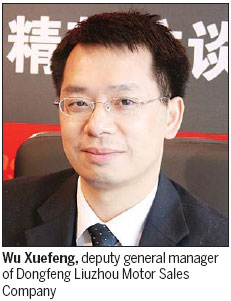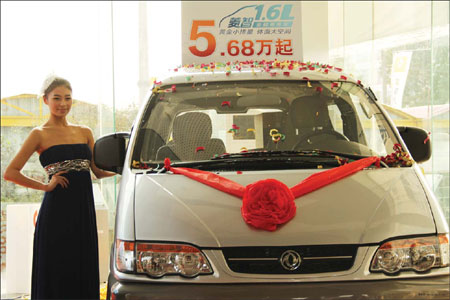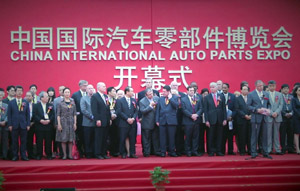Big wheels keep turning
Updated: 2013-09-20 15:36
By Wang Chao (China Daily)
|
|||||||||||
Automakers in top gear as robust demand for top-end models keeps factory lines humming
Foreign automakers are anticipating that the silver lining provided by sports utility and multipurpose vehicles in China during August will continue for the rest of the year also.
Year-on-year car sales rose by 9.3 percent in August compared with a 10.5 percent increase in July. Industry experts maintain that the uptrend, amid weak economic conditions and restrictions on new vehicle purchases, was largely propelled by SUVs and MPVs, while mid-sized sedans and other vehicles continued to see dwindling demand.
According to data provided by the China Association of Automobile Manufacturers, from January to August, sedan purchases rose by 10 percent to 7.58 million, while SUVs and MPVs recorded growth of 43 percent and 30 percent respectively.
Automobile sales, particularly of SUVs and MPVs, are expected to peak further in September, the golden month for the industry in China. Industry experts feel that the sales surge during the last four months, especially in the top-end segment, has given foreign carmakers enough confidence about full-year growth and consequently profits.
In August more than 240,100 SUVs were delivered to China, a 46 percent growth over the corresponding period in 2012. During the same period, nearly 105,600 MPVs were sold, a 60 percent year-on-year growth. Sedan sales during the same period grew by 7 percent to 899,100 units.
Though sedans have a much larger base number and hence cannot be compared with SUV and MPV sales, the surging demand in niche markets is something that cannot be ignored totally, says Zhang Xin, an auto analyst with the Shanghai-based Guotai Junan Securities.
"SUVs are essentially models suited for rough terrain. In China, however, it is the high-chassis and spacious SUVs that are driving the demand from city dwellers," Zhang says. "Most of the SUV buyers are those who already own a vehicle. They use the first car for commuting, while the SUVs are mostly for weekend travel and outdoor activities.
"The higher chassis in an SUV also allows the driver to have a better view of the terrain while driving," he says. But the real booster, Zhang says, has been the low price of SUVs launched by Chinese companies like Great Wall Motors.
"SUVs were considered to be expensive cars due to their all-terrain design. Companies like Great Wall have made the SUVs more appealing to Chinese consumers by launching models with reduced functions and cost."

Experts maintain that this is a growth opportunity that foreign automakers cannot ignore in the long run. "Though the overall SUV market, which had seen growth rates of over 100 percent two years ago, has slowed, there is still considerable demand coming in from the Chinese middle-class for SUVs," Zhang says.
Richard Wang, manager of China Automobile Trading Co, a major automobile dealer in China, says sales of European and US-made MPVs and SUVs will continue to rise on the back of robust demand from well-heeled Chinese customers.
"The current demand is for China-made MPVs and this is coming from small enterprises. Going forward, many of these businesses may soon scale up to top-end foreign models like Buick GL8 or Mercedes, as they are considered to be more reliable and command a higher social standing," Wang says.
This is more or less the same in the SUV segment also, with foreign brands slowly gaining an edge, experts say. "More than half of the people, who have already bought a B-class car, now choose imported or joint-venture SUVs as their second cars," Wang says.
"With more European compact SUVs likely to be manufactured in China, prices are set to decline further and become more appealing to customers in other segments also."
Demand is also being generated by a different set of consumers, especially those who like big and roomy cars. For these customers, space and not price is the determining factor. It is this segment that foreign automakers still have an edge over their Chinese counterparts, as shown by the surging demand for models like the BMW X5 and Audi Q7.
While foreign automakers are banking on demand from rich Chinese customers, domestic companies are banking more on fuel-efficiency and size to stay ahead.
Wu Xuefeng, deputy general manager of Dongfeng Liuzhou Motor Sales Company, says August was one of the best months in terms of sales.
To meet the increasing demand, the company launched new MPV models with updated designs that feature smaller cylinders and lower gas consumption.
"MPVs are mostly for business use, either for medium or small enterprisers in small cities, or local government departments. These customers have specific requirements like smaller cylinders, and that is why we have tweaked the design to introduce models like the M3 1.6-liter and the V3 1.5-liter."
Wu says that MPVs are finding more customers in cities across central and western China, and in rural areas on the east coast. "With the accelerated urbanization process, demand from central and western China will keep rising for the next five to 10 years," he says.
The new wave of government car purchases has also created several opportunities for MPV makers, Zhang from Guotai Securities says.
"Five years ago, the MPV market was mostly sluggish because the budget for government cars was used up by sedans. Since 2009, local governments have started to gradually phase out old cars, and the demand is for MPVs that can accommodate up to 10 people," he says.
Though foreign automakers are bullish on full-year prospects, the sluggish demand for sedans is still a cause for concern. Figures from the China Association of Automobile Manufacturers show that during the last eight months, German auto brands, including Volkswagen, BMW and Mercedes, continued to dominate the market with a market share of 28 percent, followed by Chinese and Japanese brands with 25 percent and 17 percent respectively.
Yao Jie, deputy secretary-general of CAAM, says that the inferior position of Chinese brands will continue for a long time.
"Chinese brands cannot overtake their foreign counterparts, especially brands from Germany, in the short term. For instance, the top-selling brand, Volkswagen, entered China well before most of the Chinese brands were even established. Their small-engine models fit really well with the Chinese market," Yao says.
Shi Jianhua from CAAM says that both the domestic and overseas markets have been lackluster for Chinese sedan-makers.
From May to August, exports of home-grown sedans declined steadily for four consecutive months, and there is no clear sign that this trend will reverse in September.
Shi says there are several reasons for such a situation. "First of all, global economic conditions do not offer much room for cheer. The yuan has been appreciating against most of the currencies in the destination markets and hence does not provide price advantages for Chinese companies, compared with Japanese or South Korean cars."
According to Shi, the biggest problem is the saturation of low-emission Chinese cars in the major destination markets. "As a result companies have to deploy additional resources and manpower in these markets to grow overseas sales," he says.
wangchao@chinadaily.com.cn
|
Dongfeng Liuzhou Motor Sales Company has launched new MPV models with updated designs that feature smaller cylinders and lower gas consumption. Provided to China Daily |
(China Daily European Weekly 09/20/2013 page23)
Today's Top News
Verdict of Bo Xilai: Life in prison
Russian embassy to Syria shelled
Gunmen holding hostages in Nairobi
Amber alert across Asia, but not red
China signs 12 deals with Venezuela
Bo Xilai gets life in prison
New Sino-US ties sought
One Chinese killed in Nairobi attack
Hot Topics
Lunar probe , China growth forecasts, Emission rules get tougher, China seen through 'colored lens', International board,
Editor's Picks

|

|

|

|

|

|






